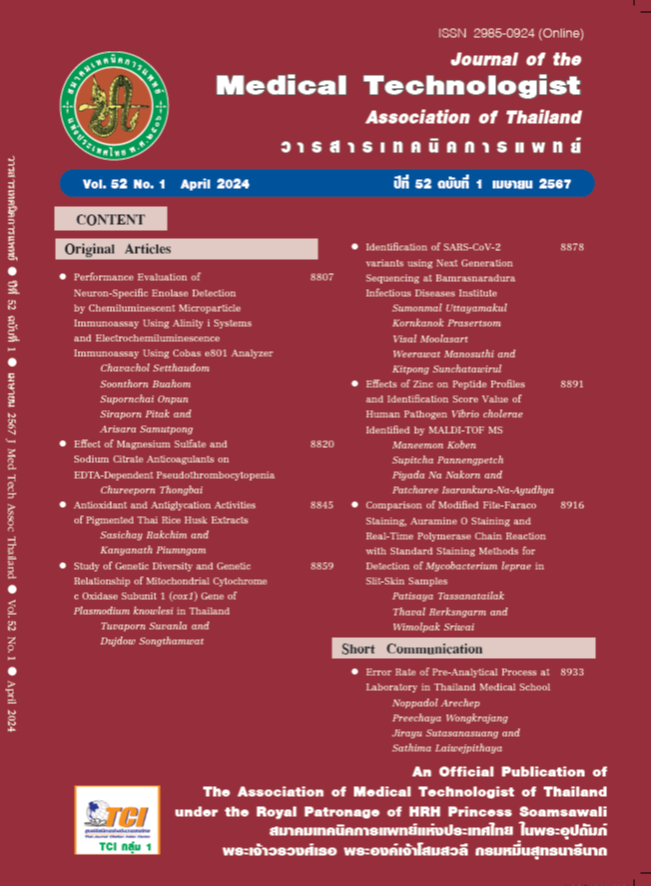การเปรียบเทียบวิธีการย้อมสี Modified Fite-Faraco การย้อมสี Auramine O และวิธี Real-Time PCR กับการย้อมสีด้วยวิธีมาตรฐานในการตรวจหาเชื้อ Mycobacterium leprae ในตัวอย่างที่เก็บจากการกรีดผิวหนัง
คำสำคัญ:
การกรีดผิวหนัง, การย้อมสีแบคทีเรียรูปแท่งติดสีทนกรด, ฟลูออเรสเซนต์, โรคเรื้อน, Modified Fite-Faraco, Real-time PCRบทคัดย่อ
การเปรียบเทียบวิธีการตรวจหาเชื้อ Mycobacterium leprae โดยวิธีการย้อมสี modified Fite-Faraco (FF) วิธี fluorescent Auramine O (AO) และการตรวจหา Pra gene ด้วยวิธี real-time PCR กับการย้อมสีด้วยวิธีมาตรฐาน Ziehl Neelsen (ZN) ในผู้ป่วยโรคเรื้อน 32 ราย ที่เข้ารับบริการรักษา โรคเรื้อนที่สถาบันราชประชาสมาสัย โดยขูดเก็บตัวอย่างสารน้ำและเนื้อเยื่อผิวหนังโดยการกรีดผิวหนัง รายละ 4 ตำแหน่ง คือ ติ่งหูทั้ง 2 ข้างและรอยโรคที่กำเริบมากที่สุดอีก 2 ตำแหน่ง เตรียมสไลด์จากตัวอย่างที่เก็บจากการกรีดผิวหนัง (slit-skin smear: SSS) ย้อมสีด้วยวิธี ZN, FF และ AO และตรวจวิเคราะห์ตัวอย่างเนื้อเยื่อด้วยวิธี real-time PCR เพื่อตรวจหา Pra gene การศึกษาครั้งนี้ได้ปรับวิธี FF ด้วยการลดขั้นตอน deparaffinization ไปเป็นการแช่สไลด์ในน้ำมันถั่วเหลืองอย่างเดียวที่อุณหภูมิห้อง 10 นาที ผลการศึกษาพบว่าวิธี ZN, FF, AO และ real-time PCR มีความสอดคล้องกันในระดับดีมาก โดยพบว่าวิธี ZN, FF และ AO ให้ผลบวกกับตัวอย่าง 7, 9 และ 11 ราย จากตัวอย่าง 32 ราย ตามลำดับ และเมื่อตรวจด้วยวิธี real-time PCR พบ M. leprae ใน 9 ตัวอย่าง และยังพบว่าวิธี FF และ AO มีประสิทธิภาพดีกว่าวิธี ZN ในการตรวจวินิจฉัยโรคเรื้อนจาก SSS นอกจากนี้ยังพบว่าวิธี FF, AO และ real-time PCR มีความไวเท่ากันในการตรวจวินิจฉัยผู้ป่วยเชื้อมาก ผลดังกล่าวจึงสรุปได้ว่า วิธี FF, AO และ real-time PCR สามารถใช้ทดแทนวิธี ZN ในการตรวจวินิจฉัยโรคเรื้อนจากตัวอย่างที่เก็บจากการกรีดผิวหนังโดยไม่สูญเสียความไวในการตรวจ วิธี FF ใช้เครื่องมือราคาถูกกว่า สะดวก และง่ายสำหรับการตรวจวัด ดังนั้นการย้อมสีด้วยวิธี FF จึงสามารถใช้เป็นวิธีการสำหรับช่วยยืนยันผู้มีอาการแสดงที่สงสัยว่าเป็นโรคเรื้อนโดยเฉพาะอย่างยิ่งในโรงพยาบาลที่มีทรัพยากรจำกัด
เอกสารอ้างอิง
World Health Organization. Guidelines for the diagnosis, treatment and prevention of leprosy. 2017 [cited 2023 April 30]:[106 p.]. Available from: https://www.who.int/ publications/i/item/9789290226383.
World Health Organization. Global leprosy (Hansen disease) update, 2021: moving towards interruption of transmission. Wkly Epidemiol Rec 2022; 97: 429-50.
WHO Expert Committee on Leprosy & World Health Organization. WHO Expert Committee on Leprosy [meeting held in Geneva from 17 to 24 November 1987]: sixth report. Geneva: World Health Organization; 1988.
WHO Expert Committee on leprosy & World Health Organization. WHO Expert Committee on leprosy: eighth report. WHO Technical Report Series [Internet]. 2012 [cited 2023 April 25]:[72 p.]. Available from: https://apps.who.int/iris/handle/10665/75151.
Buhrer-Sekula S, Smits HL, Gussenhoven GC, et al. Simple and fast lateral flow test for classification of leprosy patients and identification of contacts with high risk of developing leprosy. J Clin Microbiol 2003; 41: 1991-5.
Burgess PJ, Fine PE, Ponnighaus JM, Draper C. Serological tests in leprosy. The sensitivity, specificity and predictive value of ELISA tests based on phenolic glycolipid antigens, and the implications for their use in epidemiological studies. Epidemiol Infect 1988; 101: 159-71.
Martinez AN, Britto CF, Nery JA, et al. Evaluation of real-time and conventional PCR targeting complex 85 genes for detection of Mycobacterium leprae DNA in skin biopsy samples from patients diagnosed with leprosy. J Clin Microbiol 2006; 44: 3154-9.
Reja AH, Biswas N, Biswas S, et al. Fite-Faraco staining in combination with multiplex polymerase chain reaction: a new approach to leprosy diagnosis. Indian J Dermatol Venereol Leprol 2013; 79: 693- 700.
Job CK, Jayakumar J, Williams DL, Gillis TP. Role of polymerase chain reaction in the diagnosis of early leprosy. Int J Lepr Other Mycobact Dis 1997; 65: 461-4.
Bishop PJ, Neumann G. The history of the Ziehl-Neelsen stain. Tubercle 1970; 51: 196-206.
Tharinjaroen CS. Review article: Tuberculosis diagnosis: From knowledge to innovation in public health. JAMS 2017; 50: 1-21. (in Thai)
Adiga DS, Hippargi SB, Rao G, Saha D, Yelikar BR, Karigoudar M. Evaluation of Fluorescent Staining for Diagnosis of Leprosy and its Impact on Grading of the Disease: Comparison with Conventional Staining. J Clin Diagn Res 2016; 10: EC23- EC6.
Ngamwachiraporn S, Chomean S, Rerksngarm T. Screening test of Mycobacterium leprae infection in paubacillary Leprosy patients by Rapid serological test. TSTJ 2018; 26: 1253-63. (in Thai)
Nayak SV, Shivarudrappa AS, Mukkamil AS. Role of fluorescent microscopy in detecting Mycobacterium leprae in tissue sections. Ann Diagn Pathol 2003; 7: 78-81.
Ulukanligil M, Aslan G, Tasci S. A comparative study on the different staining methods and number of specimens for the detection of acid fast bacilli. Mem Inst Oswaldo Cruz 2000; 95: 855-8.
Kalagarla S, Alluri R, Saka S, Godha V, Undavalli N, Kolalapudi SA. Efficacy of fluorescent microscopy versus modified Fite-Faraco stain in skin biopsy specimens of leprosy cases - a comparative study. Int J Dermatol 2022; 61: 595-9.
Swamy AKC, Patra AK. A Study on Comparison between Ziehl Neelsen Staining with Auramine Rhodamine Staining in Diagnosis of Paucibacillary Leprosy. IJSR 2019; 10: 177-81.
World Health Organization. Laboratory techniques for leprosy.: World Health Organization; 1987. 177 p.
Clapasson A, Canata S. Laboratory investigations in leprosy. In: Nunzi E, Massone C, Portaels F, editors. Leprosy and buruli ulcer: a practical guide. Cham: Springer International Publishing; 2022. p. 61-70.
Rajapracha Samasai Institute. Guidelines for diagnosis of leprosy by slit-skin smear. 1st ed. Nonthaburi: National Buddhism Printing House; 2004. 73 p. (in Thai)
Truant JP, Brett WA, Thomas W, Jr. Fluorescence microscopy of tubercle bacilli stained with auramine and rhodamine. Henry Ford Hosp Med Bull 1962; 10: 287-96.
Girma S, Avanzi C, Bobosha K, et al. Evaluation of Auramine O staining and conventional PCR for leprosy diagnosis: A comparative cross-sectional study from Ethiopia. PLoS Negl Trop Dis 2018; 12: e0006706.
Wichitwechkarn J, Karnjan S, Shuntawuttisettee S, Sornprasit C, Kampirapap K, Peerapakorn S. Detection of Mycobacterium leprae infection by PCR. J Clin Microbiol 1995; 33: 45-9.
Landis JR, Koch GG. An application of hierarchical kappa-type statistics in the assessment of majority agreement among multiple observers. Biometrics 1977; 33: 363-74.
Hayes AF, Krippendorff K. Answering the Call for a Standard Reliability Measure for Coding Data. Commun Methods Meas 2007; 1: 77-89.
Pattyn SR. The problem of cultivation of Mycobacterium leprae. A review with criteria for evaluating recent experimental work. Bulletin of the World Health Organization 1973; 49: 403-10.
Jariwala HJ, Kelkar SS. Fluorescence microscopy for detection of M. leprae in tissue sections. Int J Lepr Other Mycobact Dis 1979; 47: 33-6.
Pollock HM, Wieman EJ. Smear results in the diagnosis of mycobacterioses using blue light fluorescence microscopy. J Clin Microbiol 1977; 5: 329-31.
Martinez AN, Talhari C, Moraes MO, Talhari S. PCR-based techniques for leprosy diagnosis: from the laboratory to the clinic. PLoS Negl Trop Dis 2014; 8: e2655.
Dehe BR, Coulibaly NgD, Kouakou H, et al. Comparative assessments of polymerase chain reaction (PCR) assay of repetitive sequence (RLEP) and proline rich antigen (PRA) gene targets for detection of Mycobacterium leprae DNA from paucibacillary (PB) and multibacillary (MB) patients in Côte d’Ivoire. GSCBPS 2020; 11: 085-92.
ดาวน์โหลด
เผยแพร่แล้ว
รูปแบบการอ้างอิง
ฉบับ
ประเภทบทความ
สัญญาอนุญาต
ลิขสิทธิ์ (c) 2024 วารสารเทคนิคการแพทย์

อนุญาตภายใต้เงื่อนไข Creative Commons Attribution-NonCommercial-NoDerivatives 4.0 International License.






